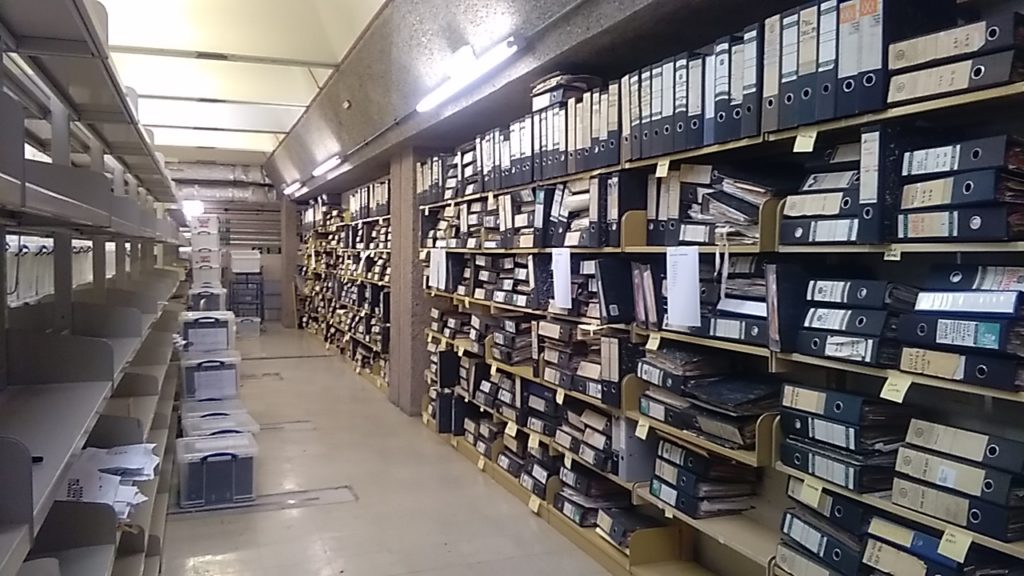Global History of Terrorism Archive
Maia Sheridan, Manuscripts Archivist, reports on leading an international effort to tackle a huge archive on international terrorism.
For those of you used to getting all your news online or through RSS feeds to your phone, step back in time to when much of what we knew about the world came from actual printed newspapers, the broadsheets and tabloids. It’s not even that long ago. A fascinating newspaper-based project has been going on in the basement of the University Library since the autumn, involving around 1600 lever arch files, each stuffed with hundreds of newspaper cuttings. These form the Global History of Terrorism Archive.
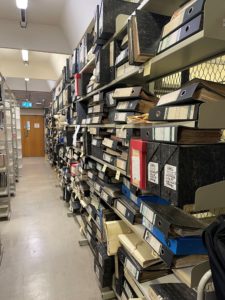 This massive collection of files came into our collections from the Centre for the Study of Terrorism and Political Violence (CSTPV), based in the School of International Relations. The files were gifted to Professor Paul Wilkinson, founder of the Centre. They were originally put together by Richard Clutterbuck, ex-army, head of the Royal College of Defence Studies, and a director of Control Risks Information Service. Control Risks was set up in the 1970s by insurance brokers, whose clients were concerned about the new wave of Irish and Palestinian terrorism in Europe. They were asking to be insured, particularly against kidnap. In response, an organisation was established which evaluated the risks to business interests in any given country. They hired security experts and many staff with military or intelligence backgrounds. Clutterbuck specialised in counter-insurgency and kidnapping. The cuttings files served as a pre-internet information resource where the background to conflicts, details of violent attacks and likely political or economic instability could be studied before giving advice. They are a valuable resource for researchers today – but how to make them accessible?
This massive collection of files came into our collections from the Centre for the Study of Terrorism and Political Violence (CSTPV), based in the School of International Relations. The files were gifted to Professor Paul Wilkinson, founder of the Centre. They were originally put together by Richard Clutterbuck, ex-army, head of the Royal College of Defence Studies, and a director of Control Risks Information Service. Control Risks was set up in the 1970s by insurance brokers, whose clients were concerned about the new wave of Irish and Palestinian terrorism in Europe. They were asking to be insured, particularly against kidnap. In response, an organisation was established which evaluated the risks to business interests in any given country. They hired security experts and many staff with military or intelligence backgrounds. Clutterbuck specialised in counter-insurgency and kidnapping. The cuttings files served as a pre-internet information resource where the background to conflicts, details of violent attacks and likely political or economic instability could be studied before giving advice. They are a valuable resource for researchers today – but how to make them accessible?
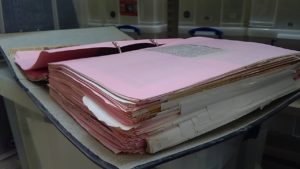
Previous attempts to gain intellectual control over the archive foundered on the enormity of the task but Professor Tim Wilson and Dr Kieran McConaghy of CSTPV were determined to take it on again. With such a vast amount of information available the only way to make some kind of sense of it all was to haul the files back from deep store, unpack them, re-arrange them into country and chronological order, and create a basic catalogue which would draw in scholars searching for violent incident keywords. This could not be comprehensive, due to time constraints, but what has been produced covers dates, main events, key names and places, and major terrorist activities including type of assault, weapon and target. The work has been done by a suitably international team of 17 students from the US and UK, Italy, Germany, Poland, Romania, India and Hong-Kong. They are mainly postgraduates in IR with an impressive array of language skills and a tolerance for death and mayhem!

The files cover events from 1975 to 1993 for 139 different countries and themes. We grouped them into 12 areas based on those used by the Global Terrorism database.
The cuttings are mainly from English language British or American papers. There are also Spanish, French and German newspapers and printouts from wire services Reuters, Associated Press and EFE. This limited range may be due to the difficulty of obtaining newspapers from further afield, or in reading them. There are none in Chinese or Russian for instance, and very few in Arabic.
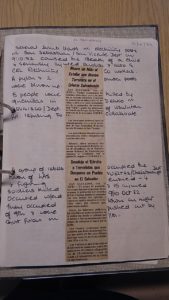
The countries we might associate with terrorism or political violence today are not always the ones focussed on back then. Muslim fundamentalism doesn’t feature as much as we would perhaps now expect, but there is plenty of detail for South Africa (apartheid), Peru (Shining Path) and all of Central America – being on the doorstep of the US and in the sights of the CIA. As someone who travelled a great deal in the 1980s, including to Peru and South Africa, I am rather glad I wasn’t aware of just how much terrorism was going on at the time. The ebb and flow of history is illustrated through the files – countries seemingly always at war with themselves or others now peaceful and prospering, including Northern Ireland and Cambodia, while others have descended into conflict as in Syria. Other countries seem to have intractable issues, where nothing much appears to have changed. There are endless predictions of the fall of Fidel Castro in Cuba 20 years before he actually stepped down from power, but the US embargo continues to this day.
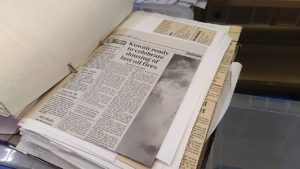
There is not only information on terrorist attacks, such as the Lockerbie bombing, and many kidnappings and airport attacks in Europe, but also background information for each country, on the state of the economy, political leanings, elections, government repression, strikes, riots, regional relationships, security issues, activism, policing and much more. Many countries have little in the way of what we would class as terrorism but there was still a value to researching their business risk in other ways. Political instability, economic chaos, aggression from neighbouring states, and war of course, including the Gulf War, Iran-Iraq war, and many conflicts in Sub-Saharan Africa – these would all be good reasons not to invest in one place or another. The time period also covers the break-up of the Soviet Union, the rocky path to independence for many of the former Soviet Republics, and the opening up of Eastern Europe – including one image I myself had up on my wall as a student in November 1989, a striking full-page cover from The Independent of Wenceslas Square in Prague at the height of the Velvet Revolution in Czechoslovakia.
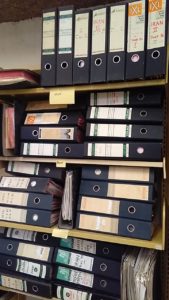 Why did we not just digitise all this and put it online? Apart from the tremendous cost and time needed to do this, legally we can’t. These articles are all still in copyright. Some, indeed many, of these articles will now be available online from the newspapers concerned, but here is an archive where the stories and the newspaper coverage have been brought together physically, without the need to scroll endlessly through the internet and fight paywalls. These files give researchers the chance to view the story from several different national perspectives, and to follow a story as it evolves through real time. The students have done a fabulous job sifting through this huge collection of papers, at speed, to pick out the most important and relevant news stories to bring to our attention. Their work will be added to our archive catalogue very soon and will be fully searchable, to make this global archive available to the research community for the first time. Even allowing for its Western perspective and the bias towards military and American or UK interests, these files are still a fascinating snapshot of the world at this time.
Why did we not just digitise all this and put it online? Apart from the tremendous cost and time needed to do this, legally we can’t. These articles are all still in copyright. Some, indeed many, of these articles will now be available online from the newspapers concerned, but here is an archive where the stories and the newspaper coverage have been brought together physically, without the need to scroll endlessly through the internet and fight paywalls. These files give researchers the chance to view the story from several different national perspectives, and to follow a story as it evolves through real time. The students have done a fabulous job sifting through this huge collection of papers, at speed, to pick out the most important and relevant news stories to bring to our attention. Their work will be added to our archive catalogue very soon and will be fully searchable, to make this global archive available to the research community for the first time. Even allowing for its Western perspective and the bias towards military and American or UK interests, these files are still a fascinating snapshot of the world at this time.
